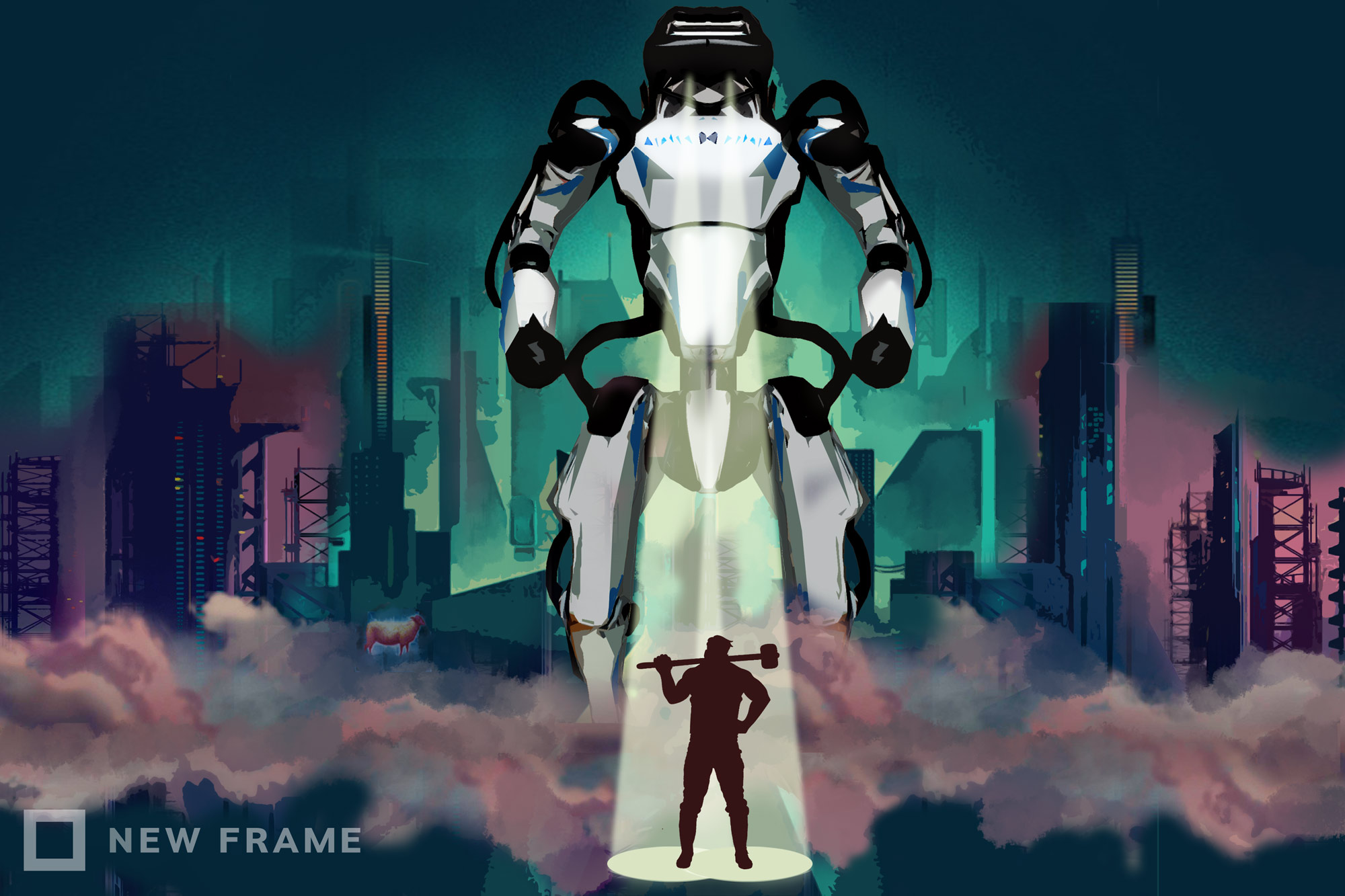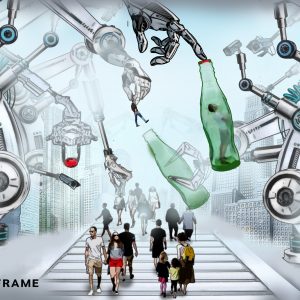The machines run amok
Science fiction offers a powerful critical perspective on the dangers of capitalist techno-optimism, the devices that divide us and the greed of their creators.
Author:
30 June 2021

The cult film Upgrade, released in 2018, has gained greater popularity since reaching Netflix this year. It is set a few decades in the future in an unnamed American city where robotic technology has increasingly replaced human workers. Those with jobs travel in beautiful self-driving cars and live in automated houses while the unemployed huddle in homeless encampments.
Weathered robots replace car mechanic Grey Trace (Logan Marshall-Green) at work. His wife, Asha Trace (Melanie Vallejo), is one of the white-collar elite who works for a tech company. Grey’s sole remaining client is the sinister inventor Eron Keen (Harrison Gilbertson).
One night, Grey and Asha visit Keen’s lavish underground bunker, where he unveils his newest creation, a computer chip called Stem. Keen predicts this device will positively change the world. Grey has a less lofty perspective. He tells Keen that while the tech guru may imagine the utopian horizon of unlimited potential, all he sees is “10 more guys on an unemployment line”.
Related article:
As with real-world plutocrats such as Bill Gates or Mark Zuckerberg, Keen is a techno-optimist. He believes that cutting-edge technology, such as automation or artificial intelligence, will always benefit society. Techno-optimists label anyone afraid of technology’s political and economic implications a “Luddite”, neurotically afraid of remote-controlled futures.
Of course, as seen by the paranoid anti-vaxxer movement, there certainly are people who do have a reactionary fear of science and technology. But while there are many areas in which technology has made our lives easier, it is naive to believe it is always beneficial.
Techno fear
In the last century, for instance, some of the greatest scientific minds of the day used their genius to develop nuclear weapons, a technology that serves no purpose beyond creating enough destructive force to kill millions and burn cities into radioactive dust. Still hulking in underground silos and lurking in submarines, these horrific weapons could destroy human civilisation in a matter of hours.
Grey’s technological anxiety is proven correct through the course of the film. Stem, it transpires, has a mind of its own. In direct contrast to its creator’s vision, it comes to regard humans as a resource to be manipulated and exploited. Ultimately, the inventor becomes the puppet of his product. There is a poetic justice to his fate – the machine he thought would make him even wealthier forces the capitalist who got rich off the labour of others into servitude.
Related article:
According to many governments and economists, humanity is in the midst of a fourth industrial revolution, or 4IR, driven by advances in robotics and computing. This is depicted as the inevitable march of progress, as op-eds urge people to reskill for this new era or face being crushed under the wheels of the future.
Automation is not being praised because it will make life easier for all, but because it will reduce work forces and consolidate the power of Silicon Valley. Along with threatening mass unemployment and further entrenching social inequality, the 4IR is already making our lives less free with the rise of surveillance capitalism in which vast conglomerates such as Google and Facebook control substantial aspects of daily existence.
Frankenstein and the Luddites
In countless films, TV shows, novels and comic books, science fiction has detailed our deepest terrors and suspicions about the unintended consequences of technological progress. This tradition of techno-paranoia can be traced back to the very beginning of the industrial revolution, when, in 1818, the 20-year-old writer Mary Shelley published Frankenstein, Or, The Modern Prometheus.
The wealthy inventor Victor Frankenstein creates a living creature by reanimating corpses with electricity. The monster he creates terrifies Frankenstein. But instead of taking responsibility for his disastrous experiment, he flees from it, with tragic consequences for everyone close to him.
Shelley was far from an anti-science reactionary. Along with being an influential creator in her own right (she wrote The Last Man in 1826, often regarded as the first fictional story about a future viral apocalypse), she was conversant with the politically and artistically radical ideas of the time. The daughter of the pioneering feminist Mary Wollstonecraft and the anarchist philosopher William Godwin, she was also married to the poet Percy Bysshe Shelley, author of some of the most famous revolutionary poetry in the English language.
Related article:
The Romantic movement, with which she was associated, was not opposed to the pursuit of scientific technology. But it saw how the Industrial Revolution in Britain destroyed natural spaces, pushed rural people off the land into hellish industrial towns and relied on the deadly labour of slaves in America. It feared technology would be used to control and destroy, rather than to liberate. When the poet William Blake saw the first major factory built in London, he described it not as a product of the future but as a “dark satanic mill”.
Inspired by radical democratic ideas, the nascent English working class resisted technological control. One form of this was a secret organisation called the Luddites, highly skilled textile workers whose work was threatened by mechanised equipment. As acts of resistance, they destroyed machine looms and sent threatening letters to mill owners who were mistreating their employees.
In modern times, the term Luddite has come to mean an ignorant and narrow-minded person. But as Gavin Muller argues in his new book, Breaking Things At Work, the Luddites were mill workers who had traditionally enjoyed a great deal of autonomy over their work. The machines threatened their collective bargaining power and freedom. Their actions were motivated by a calculated response to an existential threat to their way of life and livelihoods.
‘Men like you built the hydrogen bomb’
Despite the technological advances made in subsequent centuries, the Frankenstein myth continues to inspire fictional critiques of technology run amok.
The visual aesthetic and synthwave soundtrack of Upgrade pays homage to subversive directors, including John Carpenter and Paul Verhoeven, who were making films in the 1980s. In a decade defined by the right-wing politics of Ronald Reagan, they featured anti-authoritarian protagonists fighting against the forces of rampant corporate greed and state militarism.
The chase sequences in Upgrade harken back to James Cameron’s The Terminator (1984) and Terminator 2: Judgment Day (1991). In this series, Skynet, a computer designed by the military to run the US nuclear weapons fleet, attempts to eradicate humanity. Arrogant tech companies and militaries playing with dangerous technology they could neither understand nor control unleashed the Skynet apocalypse.
In Judgment Day – which celebrates its 30th anniversary in July – the main protagonist, Sarah Connor (Linda Hamilton), confronts Miles Dyson (Joe Morton), the scientist who will one day create Skynet. Hearing of the horrific future his work will create, Dyson tries to shirk responsibility, asking, “How were we supposed to know?”
With rage and pity for all the lives she knows will be lost to Skynet, Connor fires back, “Yeah, right? How are you supposed to know? Fucking men like you built the hydrogen bomb. Men like you thought it up. You think you are so creative. You don’t know what it’s like to really create something, to create a life, to feel it growing inside you. All you know is death and destruction.”
The dark humour of Upgrade echoes Robocop (1987), a political satire of the 1980s’ yuppie “greed is good” culture. The board of Omni Consumer Products creates a ferocious police robot, the ED-209. This terrifying automaton is designed for urban pacification in the slums of the future. But it is shown to be consistently murderous and also poorly built, as in a scene in which the metal behemoth is defeated because it can’t get down a flight of stairs.
Original screenwriter Ed Neumeier included this as a reference to the greed of the military-industrial complex, which profits from wars while sending soldiers into conflicts with faulty equipment. In Robocop, it is clear that the real danger is not the technology but the ruthless corporate greed of companies that send untested, dangerous products into the public sphere.
Anxious futures
Alongside the fear of what machines could do to us is an anxiety about our own dehumanisation. The novelist Philip K Dick was inspired to write Do Androids Dream of Electric Sheep? – which became the basis for the Blade Runner films (1982, 2017) – after reading the journal of a Nazi SS officer. In it, they complained of being unable to sleep because of the crying of children in the extermination camp in which they worked. To Dick, such people had lost empathy to the point that they were no different from a machine.
When writing The Terminator films, Cameron was referencing the dehumanising actions of police and military officers. Released a year before the 1992 mass protests in Los Angeles, which the racist brutality of the Los Angeles Police Department sparked, Judgment Day features the murderous T-1000 disguised as a police officer. (While the film was being made, amateur camera operator George Holliday filmed scenes on the set. Two months later, he would record the police assaulting Rodney King, the incident that triggered the protests.)
Related article:
Cameron told his biographer Rebecca Keegan, “The Terminator films are not really about the human race getting killed off by future machines. They’re about us losing touch with our own humanity and becoming machines, which allows us to kill and brutalise each other. Cops think all non-cops [are] less than they are, stupid, weak and evil. They dehumanise the people they are sworn to protect and desensitise themselves in order to do that job.”
Science fiction teaches us to have a healthy scepticism about technological and scientific optimism, not because we should be afraid of machines, but rather because of the greed and malice of the people who create them. Our greatest problems, from economic inequality to violence, will not be solved with techno quick-fixes but by reconnecting with the deeply human desire for justice and freedom.




